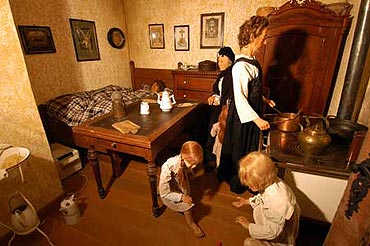Schrift: größer/kleiner
Inhaltsverzeichnis
Sie sind hier: WirRheinländer > english version > The Exhibition > Scenes > Working-class flat
Working-class flat - circa 1880

Migration from the land and a growing population rapidly pushed the number of inhabitants in towns to new heights. There was a lack of accommodation. Rents were high and consumed a large part of wages, although the "flats" often consisted of one room which served as living- and bedroom. Several people frequently shared one bed. Many families depended on income from "boarders" and "sleepers". They were shift-workers without their own flat, who paid to stay with families and slept in shifts.
In the course of time most industrial enterprises recognized the necessity of making cheap living space available to the growing influx of workers. Therefore workers' estates were built near mines and factories. The buildings were simple and of a uniform style.
This could lead to some confusion, as one miner reported:
"At the beginning my father lived as a boarder in the old settlement. In the evening… he came home from the afternoon shift, reached into a little window by the door, took the key, unlocked the door, went inside, hung his cap upon a hook…, went to the oven …and took out some roast potatoes. He sat down, began eating and glanced around: "Just a moment! There's a strange hat hanging next to my cap." Then he looked round, put the pan back, went back out, locked up and replaced the key. He had mistaken the house next door for his own."
(Zimmermann, Michael: Schachtanlage und Zechenkolonie. Leben, Arbeit und Politik in einer Arbeitersiedlung, Essen 1987, S. 47.)


